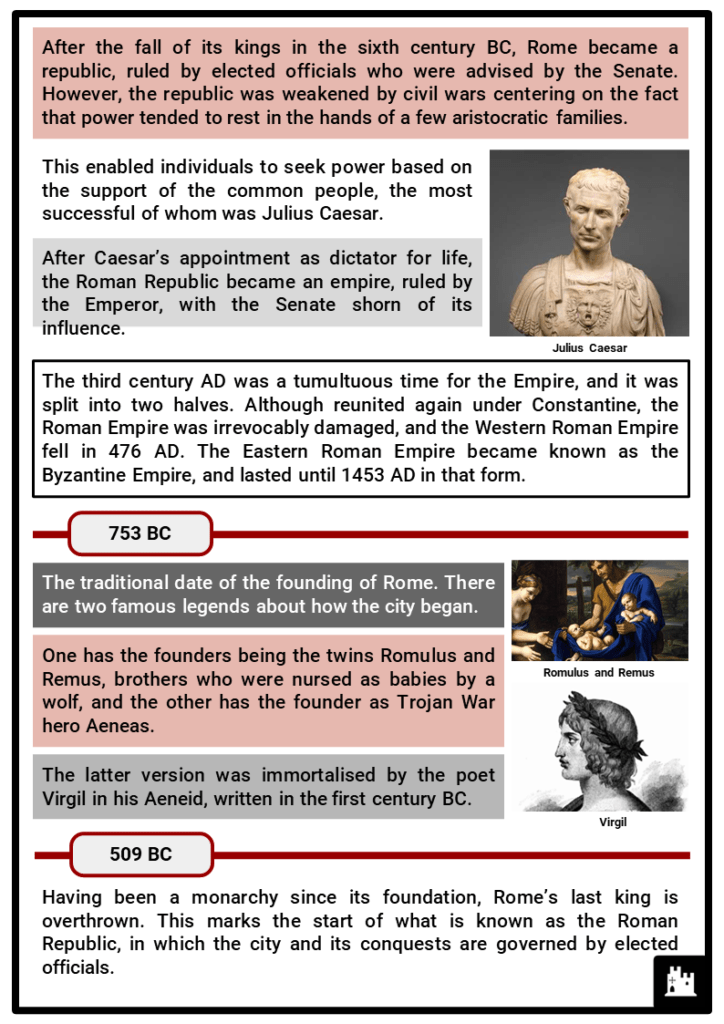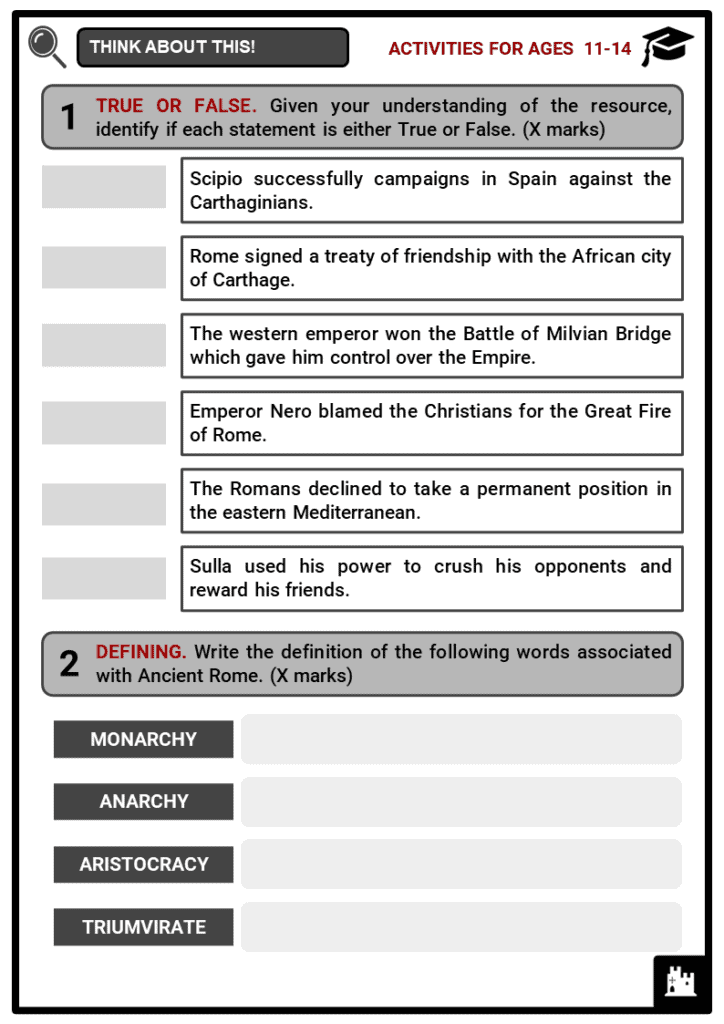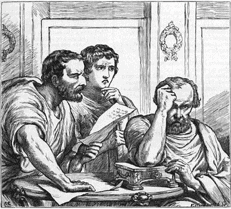Download Ancient Rome Timeline Worksheets
Do you want to save dozens of hours in time? Get your evenings and weekends back? Be able to teach Ancient Rome Timeline to your students?
Our worksheet bundle includes a fact file and printable worksheets and student activities. Perfect for both the classroom and homeschooling!
Table of Contents
Add a header to begin generating the table of contents
Summary
- Context behind the Punic Wars
- Significant leaders of Ancient Rome
- Battles won and lost
- Influences of Ancient Rome
Key Facts And Information
Let’s know more about The Ancient Rome Timeline
- The way in which a city state in Italy rose in a relatively short time to rule the entire Mediterranean world and far beyond was remarkable.
- Rome first came to dominate Italy, previously divided between Greek colonial influence and native tribes like the Latins and the Etruscans, before looking outwards to the western Mediterranean and then in the other direction towards Greece and the Near East.
- After the fall of its kings in the sixth century BC, Rome became a republic, ruled by elected officials who were advised by the Senate. However, the republic was weakened by civil wars centering on the fact that power tended to rest in the hands of a few aristocratic families.
- This enabled individuals to seek power based on the support of the common people, the most successful of whom was Julius Caesar.
- After Caesar’s appointment as dictator for life, the Roman Republic became an empire, ruled by the Emperor, with the Senate shorn of its influence.
- The third century AD was a tumultuous time for the Empire, and it was split into two halves. Although reunited again under Constantine, the Roman Empire was irrevocably damaged, and the Western Roman Empire fell in 476 AD. The Eastern Roman Empire became known as the Byzantine Empire, and lasted until 1453 AD in that form.
- 753 BC
- The traditional date of the founding of Rome. There are two famous legends about how the city began.
- One has the founders being the twins Romulus and Remus, brothers who were nursed as babies by a wolf, and the other has the founder as Trojan War hero Aeneas.
- The latter version was immortalised by the poet Virgil in his Aeneid, written in the first century BC.
- 509 BC
- Having been a monarchy since its foundation, Rome’s last king is overthrown. This marks the start of what is known as the Roman Republic, in which the city and its conquests are governed by elected officials.
- The most important officials are called consuls: there are two at a time, elected for a term of a year, with the intention that one could stop the other from abusing his power. If abuse was suspected, the consul could be prosecuted later.
- In the same year, the most important of all Roman temples is dedicated – the Temple of Jupiter on the city’s Capitoline Hill. At around the same time, Rome signs a treaty of friendship with the African city of Carthage so that each could concentrate on the more dangerous (at that time) enemies – the Greeks and Etruscans.
- 264 BC
- Friendship between Rome and Carthage ends with the outbreak of the First Punic War (so called because the Latin word for Carthaginian was ‘Punicus’), as the two fight for supremacy in the western Mediterranean.
- According to the later Roman historian Livy, the first gladiatorial games are also performed in Rome this year.
- 241 BC
- The First Punic War ends with a Roman naval victory of the Aegates Islands, near Sicily. In the peace treaty that follows, Carthage agrees that Rome will now control Sicily, changing the balance of power in the Mediterranean.
- 219 BC
- Carthaginian commander Hannibal besieges and captures Saguntum, a city allied to Rome on the Mediterranean coast of Spain.
- 218 BC
- As a result of the Carthaginian occupation of Saguntum, the Second Punic War begins.
- Hannibal invades Italy via the unexpected route of going overland from Spain and crossing the Alps with his army, which includes 37 elephants.
- He wins a series of victories against the Romans as he advances.
- 216 BC
- Hannibal’s tactics lead to a spectacular defeat of the Romans at the Battle of Cannae, after which several Roman allies lose confidence and switch sides to support Carthage.
- However, Rome retains enough support to still be able to outnumber Hannibal’s troops on the battlefield after the defeat at Cannae.
- 211-206 BC
- The young, charismatic Roman commander Scipio successfully campaigns in Spain against the Carthaginians, winning over local support due to his humanitarian treatment of conquered people.
- He scores a decisive victory at the Battle of Ilipa in 206 BC, forcing the Carthaginians to leave Spain and give control of the southern and eastern areas of the country, then known as Hispania, to Rome.
- 202 BC
- Scipio pursues the Carthaginians to Africa and defeats Hannibal at the Battle of Zama, gaining the nickname ‘Africanus’.
- After its defeat, Carthage is forbidden from having an army or navy, but some in Rome are disappointed that Scipio did not destroy the city of Carthage itself, fearing that it will come back to challenge Rome again.
- 196 BC
- The Romans declare the Greek states to be ‘free’ after intervening diplomatically and militarily to protect them against Philip V of Macedon in the Second Macedonian War.
- At this stage Rome apparently does not seek any territory in the eastern Mediterranean.
- c168 BC
- Following Rome’s victory at the Battle of Pydna in the Third Macedonian War, the once-great Kingdom of Macedon is dissolved into four Roman client states. The Romans decide that it is necessary for them to take a permanent position in the eastern Mediterranean so that peace can be maintained.
- 164-149 BC
- Rome declares the Third Punic War on Carthage after Carthage raises an army against Numidia without Rome’s permission. Carthage is besieged and then burned to the ground, while its territory is seized and turned into the Roman province of Africa, an area including modern-day Tunisia and parts of Algeria and Libya.
- 91-88 BC
- After a series of failed attempts to reform the rules around who could become a Roman citizen, the Social War breaks out between Rome and many of its Italian allies.
- Although the Italians fought alongside the Romans for centuries, they have not been rewarded with citizenship and its associated privileges. Although the Romans are winning the war, they decide to end it by making citizenship available to the Italians.
- 88-87 BC
- Successful general and seven-times consul (the Roman Republic’s highest rank) Marius goes to war with fellow general Sulla over the right to be appointed military commander in the East.
-
- Sulla commits the previously unthinkable act of marching his troops into Rome itself. The long-term consequence of the war between the factions of Marius and Sulla is the destabilisation and ultimate fall of the Roman Republic, to be replaced by hereditary rule under the Emperors.
- 82 BC
- Sulla is appointed dictator of Rome, a title not used since the Second Punic War and one intended for use in an emergency, giving one person total power. As dictator, Sulla uses his power to crush his opponents and reward his friends.
- 73-71 BC
- A revolt of Roman slaves led by Spartacus in Italy causes consternation in Rome before it is brutally suppressed by Roman armies under the command of Crassus and Pompey, among others.
- 60 BC
- An informal alliance is brokered between Pompey, Crassus and Julius Caesar, to help each man further his own ambitions. It is known as the First Triumvirate.
- Pompey had a great military reputation, Crassus was incredibly wealthy, while Caesar had great support among the plebs (the common people of Rome). The triumvirate was a way for the three to avoid the checks and balances built in to the Republican system and enhance their own power.
- 58-49 BC
- Caesar campaigns in Gaul, hoping that he can use the rewards of conquests to pay off debts he has in Rome. While on campaign he writes an account of it called The Gallic War, with which he hopes to convince the Roman people that he is trying to win glory for Rome, not power for himself.
- 55-54 BC
- Caesar crosses the English Channel in two successive years to campaign in Britain. On the second attempt he manages to march from the south coast across the River Thames, claiming a Celtic leader as a hostage and demanding that the local tribes pay tribute to Rome. However, the Romans do not stay in Britain at this time.
- 49 BC
- Caesar brings his army across the Rubicon river into Italy, an act which triggers a Roman civil war between Caesar’s popular faction and the supporters of the Senate. Caesar’s now rival Pompey leaves Rome for the East to gather his own army.
- 44 BC
- Victory at the Battle of Munda in 45 BC gives Caesar victory in the civil war. In February 44 BC he is appointed dictator of Rome for life.
- This absolute power horrifies some Romans, and Caesar is assassinated a month later on the Ides of March (15 March) by a group of senators.
- 43 BC
- The Second Triumvirate is formed from three of Caesar’s leading supporters, Mark Antony, Lepidus and Octavian (Caesar’s preferred heir).
- The group has official powers making them the most important men in Rome. Antony’s most prominent critic, the Republican statesman Cicero, is murdered on Antony’s orders.
- 42 BC
- Two of Caesar’s assassins, Brutus and Cassius, commit suicide after their troops are defeated by Octavian and Antony at Philippi.
- 31 BC
- After the Second Triumvirate ends in 33 BC, Octavian and Antony begin vying for power. Antony’s relationship with the Egyptian Pharaoh Cleopatra makes other Romans suspicious of his intentions.
- In 31 BC, Octavian defeats Mark Antony and Cleopatra in a naval battle at Actium. Unable to muster enough support to continue fighting Octavian, Antony commits suicide, and the following year Cleopatra does the same.
- 27 BC
- Although he proclaims the ‘Republic restored’, by 27 BC Octavian is the sole ruler of Rome. He is granted the titles of Princeps (First Citizen) and Augustus (Venerated), the latter becoming the name by which he is known to history.
- 20 BC
- Rome agrees a settlement with the Parthian Empire (a territory based around modern-day Iran) and the Parthians return the Roman Eagle standards humiliatingly lost in battle under the command of Crassus in 53 BC.
- 9 AD
- The Battle of the Teutoburg Forest in Germany ends in disaster for the Romans when three legions commanded by Varus are wiped out. Augustus is said to be distraught by the defeat.
- 14 AD
- Augustus dies, and the nature of his power as an emperor (and the end of the Roman Republic) is confirmed as his stepson Tiberius becomes ruler in a planned succession.
- 43 AD
- During the reign of the Emperor Claudius, Britain is successfully invaded under the command of Aulus Plautius.
- 61 AD
- The British Iceni tribe revolt against Roman rule under their queen, Boudicca. The rebels destroy the Roman capital Camulodunum (Colchester, Essex), Londinium (London) and Verulamium (St Albans, Hertfordshire) before being defeated.
- 64 AD
- The Great Fire of Rome burns for six days – many ancient accounts accuse Emperor Nero of causing the fire to clear space for his building projects. However, Nero blames the Christians, followers of what is at this point a very new religion, encouraging the first organised persecution of that group.
- 69 AD
- After Nero commits suicide in 68 BC rather than face trial for his various crimes, the Julio-Claudian line of emperors ends.
- The struggle for power that ensues leads to the so-called Year of the Four Emperors: Galba, Otho, Vitellius and Vespasian, the last of whom brings an end to the conflict and founds the Flavian dynasty.
- 70 AD
- The first Jewish-Roman war leads to the Siege of Jerusalem, following which the Romans capture the city and destroy the Temple.
- 79 AD
- Mount Vesuvius erupts, destroying the nearby towns of Pompeii and Herculaneum. The naturalist and writer Pliny the Elder dies, possibly of a heart attack, while mounting a rescue attempt for people trapped near the eruption.
- 80 AD
- The short reign of Emperor Titus is blighted by disaster – in addition to the eruption of Vesuvius in 79 AD, fire and plague devastate Rome in 80 AD. However, the Colosseum is also completed and opened.
- 100-111 AD
- Tacitus, one of Rome’s leading historians, writes his Histories (covering the rise of the Flavian dynasty) and Annals, dealing with the reign of Augustus onwards.
- 174-180 AD
- Emperor Caracalla issues an edict granting citizenship to all free inhabitants of the Empire.
- 212 AD
- The period of the Military Anarchy sees turmoil throughout the Roman Empire and around twenty different Emperors.
- 284-306 AD
- Emperor Diocletian reestablishes central power and stabilises the Empire. He founds the Tetrarchy, a system in which the Roman Empire is split into two halves, West and East, each ruled by an emperor, ‘Augustus’, and a junior co-emperor or ‘Caesar’.
- 312 AD
- Eastern Emperor Constantine wins the Battle of Milvian Bridge against his western co-emperor. Victory gives him total control over the Empire.
- In the following year he issues the Edict of Milan, making Christianity an official and tolerated religion. He becomes the first Roman Emperor to convert to Christianity on his deathbed in 337 AD.
- 324 AD
- Constantinople is founded as the Roman Empire’s new capital, marking the shift in importance of the East over the western portion of the Empire.
- 395 AD
- After the death of Emperor Theodosius, the Roman Empire is divided between his sons, and is never ruled as one entity again.
- 410 AD
- For the first time in eight centuries, the city of Rome is invaded by a foreign power, sacked by Alaric the Visigoth (an early Germanic people).
- 410-411 AD
- Western Roman Emperor Honorius tells Britain to organise its own defences against incursions by Germanic tribes – this in effect is Rome giving up its claim on Britain.
- 476 AD
- The official date of the end of the Western Roman Empire, when Odoacer overthrows Romulus Augustus, the last Emperor, and proclaims himself King of Italy. The Eastern Roman Empire continues until the 15th century AD as the Byzantine Empire.
Image sources:
- https://upload.wikimedia.org/wikipedia/commons/thumb/e/ef/Mommsen_p265.jpg/440px-Mommsen_p265.jpg
- https://upload.wikimedia.org/wikipedia/commons/thumb/9/99/Sulla_Glyptothek_Munich_309.jpg/340px-Sulla_Glyptothek_Munich_309.jpg
- https://upload.wikimedia.org/wikipedia/commons/thumb/5/58/Lepidus%2C_Antony_and_Octavian_in_Shakespeare%27s_Julius_Caesar.jpg/440px-Lepidus%2C_Antony_and_Octavian_in_Shakespeare%27s_Julius_Caesar.jpg
- https://upload.wikimedia.org/wikipedia/commons/3/3e/Robert%2C_Hubert_-_Incendie_%C3%A0_Rome_-.jpg










